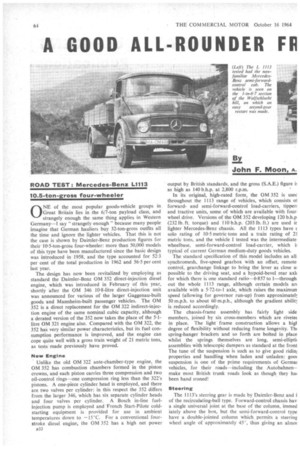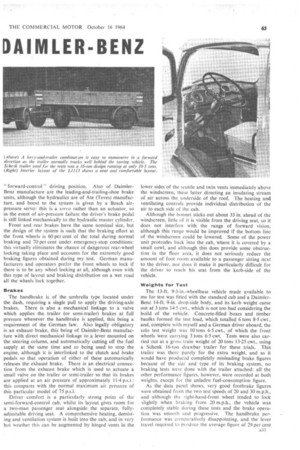A GOOD ALL-ROUNDER Fll DAIMLER-BENZ
Page 66

Page 67

If you've noticed an error in this article please click here to report it so we can fix it.
10.5-ton-gross four-wheeler, ONE of the most popular goods-vehicle groups in Great Britain lies in the 6/7-ton payload class, and strangely enough the same thing applies in Western Germany—I say "strangely enough" because many people imagine that German hauliers buy 32-ton-gross outfits all the time and ignore the lighter vehicles. That this is not the case is shown by Daimler-Benz production figures for their 10.5-ton-gross four-wheeler: more than 50,000 models of this type have been manufactured since the basic design was introduced in 1958, and the type accounted for 52-3 per cent of the total production in 1962 and 56.5 per cent last year.
The design has now been revitalized by employing as standard the Daimler-Benz OM 352 direct-injection diesel engine, which was introduced in February of this year, shortly after the OM 346 1.0.8-litre direct-injection unit was announced for various of the larger Gaggenau-built goods and Mannheim-built passenger vehicles. The OM 352 is a direct replacement for the OM 322 indirect-injection engine of the same nominal cubic capacity, although a derated version of the 352 now takes the place of the 5Ilitre OM 321 engine also. Compared with the OM 322, the 352 has very similar power characteristics, but its fuel consumption performance is improved, and the engine can cope quite well with a gross train weight of 21 metric tons, as tests made previously have proved.
New Engine
Unlike the old OM 322 ante-chamber-type engine, the OM 352 has combustion chambers formed in the piston crowns, and each piston carries three compression and two oil-control rings—one compression ring less than the 322's pistons. A one-piece cylinder head is employed, and there are two valves per cylinder: in this respect the 352 differs from the larger 346, which has six separate cylinder heads and four valves per cylinder. A Bosch in-line fuelinjection pump is employed and French Start-Pilote coldstarting equipment is provided for use in ambient temperatures down to —15°C. For a conventional fourstroke diesel engine, the OM 352 has a high net power output by British standards, and the gross (S.A.E.) figure i! as high as 14013,11.p. at 2,800 r.p.m.
In its original, high-rated form, the OM 352 is user throughout the 1113 range of vehicles, which consists 01 forwardand semi-forward-control load-carriers, tipper and tractive units, some of which are available with four. wheel drive. Versions of the OM 352 developing 120 b.h.p (232 lb. ft. torque) and 110 b.h.p. (203 lb. ft.) are used ir lighter Mercedes-Benz chassis. All the 1113 types have t solo rating of 10-5 metric tons and a train rating of 21 metric tons, and the vehicle I tested was the intermediate wheelbase, semi-forward-control load-carrier, which i! typical of current German medium-duty goods vehicles.
The standard specification of this model includes an all synchromesh, five-speed gearbox with an offset, remote control, gearchange linkage to bring the lever as close a! possible to the driving seat, and a hypoid-bevel rear axlc for which there is one standard ratio-6.857 to 1—through out the whole 1113 range, although certain models an available with a 5-72-to-1 axle, which raises the maximun speed (allowing for governor run-up) from approximate!! 50 m.p.h. to about 60 m.p.h., although the gradient abilit! is reduced accordingly.
The chassis-frame assembly has fairly light side members, joined by six cross-members which are rivetet in place. The light frame construction allows a higt degree of flexibility without reducing frame longevity. Thl spring-hanger brackets and so forth are bolted in place whilst the springs themselves are long, semi-ellipti4 assemblies with telescopic dampers as standard at the front The tune of the suspension is such as to give good ridinl properties and handling when laden and unladen: gaol suspension is one of the prime requirements of Germai vehicles, for their roads—including the Autobahnenmake most British trunk roads look as though they hal been hand ironed!
Steering
The 1113's steering gear is made by Daimler-Benz and i of the recirculating-ball type. Forward-control chassis hay a single universal joint at the base of the column, immed iately above the box, but the semi-forward-control type have a double-jointed column which permits a steerinE wheel angle of approximately 45°, thus giving an almo!
" forward-control " driving position. Also of DaimlerBenz manufacture are the leading-and-trailing-shoe brake units, although the hydraulics are of Ate (Teves) manufacture, and boost to the system is given by a Bosch airpressure servo: this is a servo rather than an actuator, so in the event of air-pressure failure the driver's brake pedal is still linked mechanically to the hydraulic master cylinder.
Front and rear brakes have the same nominal size, but the design of the system is such that the braking effort at the front wheels is 60 per cent of the total during normal braking and 70 per cent under emergency-stop conditions: this virtually eliminates the chance of dangerous rear-wheel locking taking place and accounts for the extremely good braking figures obtained during my test. German manufacturers and operators prefer the front wheels to lock if there is to be any wheel locking at all, although even with this type of layout and braking distribution on a wet road all the wheels lock together.
Brakes
The handbrake is of the umbrella type located under the dash, requiring a single pull to apply the driving-axle brakes. There is also a mechanical linkage to a valve which applies the trailer (or semi-trailer) brakes at full pressure whenever the handbrake is applied, this being a requirement of the German law. Also legally obligatory is an exhaust brake, this being of Daimler-Benz manufacture with direct mechanical linkage to a lever mounted on the steering column, and automatically cutting off the fuel supply at the same time and so being used to stop the engine, although it is interlinked to the dutch and brake pedals so that operation of either of these automatically releases the exhaust brake. There is an electrical connection from the exhaust brake which is used to actuate a small valve on the trailer or semi-trailer so that its brakes are applied at an air pressure of approximately 11-4 psi.: this compares with the normal maximum air pressure of this particular model of 75 p.s.i.
Driver comfort is a particularly strong point of the semi-forward-control cab, whilst its layout gives room for a two-man passenger seat alongside the separate, fullyadjustable driving seat. A comprehensive heating, demisting and ventilation system is built into the cab, and in very hot weather this can be augmented by hinged vents in the lower sides of the scuttle and twin vents immediately above the windscreen, these latter directing an insulating stream of air across the underside of the roof. The heating and ventilating controls provide individual distribution of the air to each side of the cab.
Although the bonnet sticks out about 33 in. ahead of the windscreen, little of it is visible from the driving seat, so it does not interfere with the range of forward vision, although this range would be improved if the bottom line of the windscreen could be lowered. Some of the power unit protrudes back into the cab, where it is covered by a small cowl, and although this does provide some obstruction in the floor area, it does not seriously reduce the amount of foot room available to a passenger sitting next to the driver, nor does it make it particularly difficult for the driver to reach his seat from the kerb-side of the vehicle.
Weights for Test
The 13-ft. 9-3-in.-wheelbase vehicle made available to me for test was fitted with the standard cab and a DaimlerBenz 14-ft. 9-in, drop-side body, and its kerb weight came out at 3 tons 14-5 cwt., which is not too bad considering the build of the vehicle. Concrete-filled boxes and timber baulks formed the test load, which totalled 6 tons 8-5 cwt., and, complete with myself and a German driver aboard, the solo test weight was 10 tons 6-5 cwt., of which the front wheels weie carrying 3 tons 6.5 cwt. Tests were also carried out at a gross train weight of 20 tons 13.25 cwt,, using a Schenk 16-ton drawbar trailer for these trials. This trailer was there purely for the extra weight, and as it would have produced completely misleading brake figures because of the size and type of its braking system, no braking tests were done with the trailer attached: all the other performance figures, however, were recorded at both weights, except for the unladen fuel-consumption figure.
As the data panel shows, very good footbrake figures were obtained from the two test speeds of 20 and 30 m.p.h., and although the right-hand-front wheel tended to lock slightly when braking from 20 m.p.h., the vehicle was completely stable during these tests and the brake operation was smooth and progressive. The handbrake performance was comparatively disappointing, and the lever travel required to produce the average figure of 29 per cent




































































































































